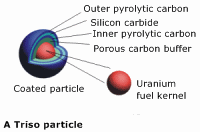First fuel particles made in South Africa
14 January 2009
The company developing the Pebble Bed Modular Reactor has reached a milestone towards making the fuel 'pebbles' for the future reactor.

PBMR is to be fuelled by balls of 'low enriched uranium triple-coasted isotropic particles' known as LEU-Triso particles.
To make these, a microsphere of uranium nitrate is gelled and calcinated (baked at high temperature) to produce a 'kernel'. These are then run through a chemical vapour disposition furnace at 1000 ºC in an inert argon environment.
The first layer deposited is porous carbon, which accommodates any mechanical deformation the kernel may suffer. Next comes dense pyrolytic carbon, silicon carbide and more pyrolytic carbon to provide an impenetrable barrier to highly radioactive products of nuclear fission. The particle now measures almost 1 mm in diameter.
About 15,000 of these particles are mixed with graphite powder and resin before being pressed into 50 mm diameter spheres. A final 5 mm coating of graphite is then added before annealing and machining.
|
PBMR announced that coated fuel particles had been manufactured at its Pelindaba laboratory using uranium enriched to 9.6%. These were sent for compaction into samples at the USA's Oak Ridge National Laboratory on 5 January, about one month after their creation. They will later travel to Idaho National Laboratory for irradiation testing.
As a South African national project, the PBMR promises to be an advanced reactor which would gain efficiency in construction through a modular design which enables sharing of certain plant buildings and machinery. Each reactor unit would produce 165 MWe and these could be built in groups of up to eight.
PBMR's operational benefits would be a very high level of safety and the ability to produce high temperature process heat for industrial use instead of electricity. It is cooled by helium and fuelled by tiny uranium particles coated and formed into small graphite balls. PBMR Pty consider that "no human error or equipment failure could cause an accident that would harm the public," due to the design's inherent safety.
Graphite essential to the production of actual usable PBMR fuel is to be manufactured by SGL Carbon, after permission to start production was granted by safety regulators in September 2008.
Construction of a demonstration reactor unit was contracted to a consortium of SNC Lavalin and Murray & Roberts in August 2008, but PBMR Pty did not mention progress on this in its announcement. Instead the design was linked to the US Department of Energy's Next Generation Nuclear Plant project, which is meant to end with the completion of an advanced reactor around 2021 at Idaho National Laboratory.
PBMR is linked to NGNP through a range of research and development deals with the DoE. The design is backed as a candidate for NGNP by Westinghouse, the Institute of Nuclear and New Energy Technology (INET) at China's Tsinghua University, the Shaw Group, Sargent and Lundy as well as PBMR Pty.
Other options for NGNP are General Atomics GT-MHR and Areva's similar Antares design. Both of these would also employ Triso fuel, although in small hexagonal prismatic cores rather than a large number of spheres.